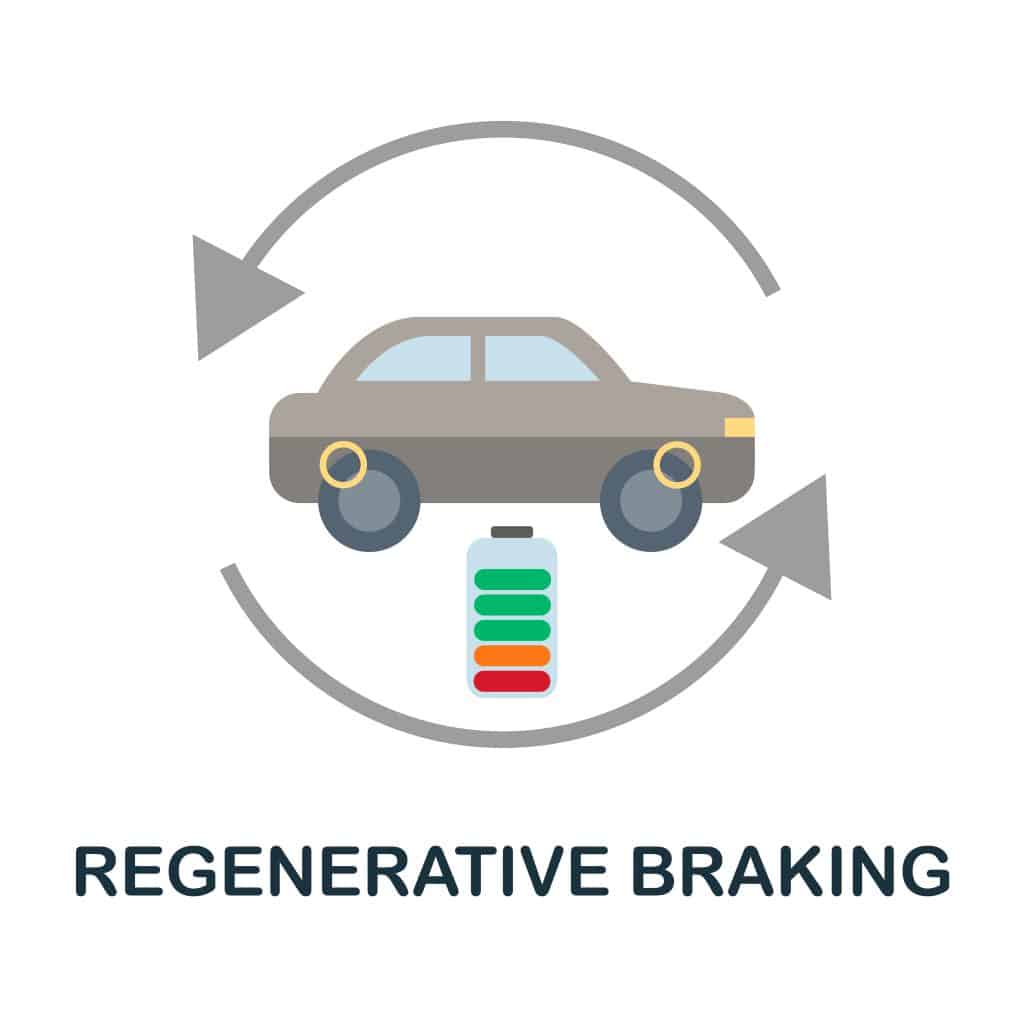For so many years we have been driving cars on a similar maintenance schedule, with one component in particular proving to be a big player in the realm of “wear and tear” – we’re talking of course of the humble brakes. The brake pads naturally wear down as a part of their regular function, and the same has been true ever since brake pads were first conceived as an alternative to drum brakes in 1902 by F.W. Lanchester. But now there has finally come an alternative: regenerative braking.
In today’s blog, we’re looking at the advantages and disadvantages of regenerative braking technology — aka “Regen” — as well as trying to understand how it was developed and the principles upon which it works.
Background: Development of Regenerative Braking

While the basic principles of regenerative braking have not changed, the efficiency and performance of the technology certainly have. First we will discuss the earliest form of EV regenerative braking. It first emerged in hybrid models as a way of extending the battery life further and allowing greater electric range.
Basic Idea – How It Works
Regenerative braking takes advantage of the construction of a typical electric motor that drives an EV along. The basic procedure is that when you accelerate, current is sent to the stator in the electric motor, which powers an electromagnet that spins the rotor around, which then turns the wheels and propels the vehicle forward. That’s a simplified account, but those are the constituent facts.
Regen braking takes advantage of times when the driver takes their foot from the gas pedal and starts turning in the other direction. Now, instead of propelling the wheels forward, the motion of the car and reverse turn of the motor is generating electrical energy that is sent to the battery pack to help recharge it. The technology is nowhere no close to creating a near self-sustaining EV, but even early results have been promising so far.
Early Hybrids
The early hybrid models integrated a way for the driver to apply the hydraulic brakes lightly at first, which engaged regen braking by reversing the direction of the motors. Drivers who needed a firmer more urgent stop could press the brakes down harder, and it would switch to hydraulic brakes and stop the car in the more “traditional” way.
The problem with this early technology was that many complained of the spongy brake pedals with less-than responsive stopping. It was a big adjustment for people to have “two levels” of braking within one pedal. This is why it evolved to its modern state.
Modern Variations of Regenerative Braking
Nissan Leaf

The Nissan Leaf was the first car to evolve regenerative braking to a one-pedal system that they call the e-Pedal. This restored the brake pedal to its regular exclusive function of hydraulic braking. Regenerative braking was now activated simply by the driver removing their foot from the e-Pedal, after which regenerative braking would engage.
As the system slowed the car, it was constantly channeling power back into the Leaf battery. The system proved very popular among the Leaf’s city-dwelling fans who often found themselves in traffic jams and no longer had to jump from one pedal to the other, and found that the effect was enough to bring them to a complete stop every time.
Tesla

Tesla was rather late to the party but is now undeniably a major player in the world of regen technology. Tesla’s regen works in much the same way that the e-Pedal does, with the driver just removing their foot from the accelerator pedal, at which time regen automatically kicks in.
Tesla drivers know their regen is kicking in because the blue line that normally juts to the right to show their acceleration under the speed indicator suddenly juts to the left to demonstrate that regen is starting to work.
In the next two sections, we’ll start to explore the advantages and disadvantages of regenerative braking.
What Are the Advantages of Regen Braking?
1. Takes Pressure Off Hydraulic Brakes
The first and most obvious advantage is how much it saves the hydraulic brakes from wear and tear. This is especially true of those using one-pedal driving to commute in and around the city. Even when traveling at slow speeds, the need to suddenly apply the brakes because you misjudged a distance or got momentarily distracted means that the brakes are getting quite a workout. Even without that urgent factor, they are being pumped over and over and over when they are the only way to slow the car.
Regen takes huge amounts of that pressure away. With a one-pedal system, the driver now only needs to ever brake in an emergency stop situation, which are relatively rare. The rest of the time, the braking can be done via the electric motor. The result is longer-lasting brake pads, reduced maintenance costs and longer-living brake rotors, too.
2. It Doesn’t Require Traditional Brakes to be Removed/Replaced

Often a new technology has to be installed at the cost of the old one, but with regen braking, this is just not the case. The inclusion of a regen braking system doesn’t require that the regular system get taken away or replaced. It can work alongside regular brakes, allowing drivers to benefit from the best of both worlds.
When the one-pedal system will do, then it’s there for the driver to use, but when a harsher brake is needed, the modern, cutting-edge hydraulic brakes are ready to go, as keen as ever and no longer diminished like they were in the early days of regen braking in hybrid cars.
3. Improvements to Fuel Economy and EV Range
If you’re using a hybrid model, then increasing the amount of power flowing into the battery pack helps prolong electric-only driving and reduce reliance on the internal combustion engine when the electric components run out of juice. The longer they go, the less gas they use.
In an electric car, the principle too is that regenerative braking can boost overall range to some degree. It’s not earth-shattering, but some of the most generous estimates have claimed that Teslas can enjoy 30 percent more range when regen braking is frequently and efficiently engaged. That kind of return however, requires a car to be rolling down a hill over and over, which is hardly practical or realistic.
4. Allows One-Pedal Driving – Easier on the Urban Driver
Finally, the regen braking system allows for one-pedal driving, which in the city is a welcome change to the constant shifting dance of moving your one driving foot from gas pedal to brake, back to gas, back to brake, back and forth, back and forth. It gets exhausting and tiresome, and the one pedal system allows you to rely exclusively on the gas pedal.
Furthermore, only using manual hydraulic brakes means misjudging situations, sometimes pressing too hard and creating a jerky, uneven and uncomfortable journey for driver and passengers alike.
What Are the Disadvantages of Regenerative Braking?
1. Not Always Strong Enough to Stop Vehicle Completely
There is some worry about regen braking not always being strong enough to stop the car completely. Nissan Leaf have been working hard to ensure and guarantee that the Leaf will always stop on time, but early Tesla models with the “low” regen setting would rarely stop the car all the way. Now that everyone is using “standard” regen, the performance is improved, but drivers have to be ever-vigilant about the braking not stopping the car entirely.
2. Can Result in Panic Braking
Not being able to stop all the way means that some drivers might realize too late and be forced to do sudden panic emergency braking, which is very unsettling, not to mention uncomfortable for passengers on board. The panic braking can negate some of the stress that is saved from your hydraulic brakes when you’re not using them.
3. Chips Away at Driver Responsibility

Regen braking is a kind of automatic driver assistance system, and one of the constant negative impacts of those is that they strip away a driver’s own sense of responsibility as they start to rely increasingly on the technology to do certain jobs for them. This ultimately leads to dangerous complacency (see below), but in the early stages wears away at a driver’s own sense of vigilance and responsibility on the road. It’s not always entirely the fault of drivers, either, since these types of assistance features are often marketed as the cars becoming self-driving, autonomous and no longer needing our input.
4. Increases Complacency
The ultimate result of the above disadvantage is a dangerous complacency that can actually put lives at risk. If you’re always sure that your regen braking will slow you down enough and bring you to a complete stop, you might start to get bolder with speeds and braking distances. This eventually can erupt into a fatal accident. Complacency is a terrible enemy of any driver, no matter how smart and advanced the car is.
Conclusion: What’s the Verdict? Is Regen Worth It?
Overall, it’s fair to say that the benefits of regenerative braking outweigh these negative points. The fact remains that complacent and irresponsible drivers remain in the minority, and so good drivers have nothing real to fear from this technology. In fact, they should embrace it and enjoy the many benefits, especially for those who are living in cities.
One day, the technology could increase in efficiency to the point where the range almost doubles on an EV. That would be a great day!
2 comments
[…] The brakes on the Toyota Aqua Hybrid frequently respond quickly in slick conditions, which could cause skidding. The car has regenerative brakes, which are distinct from conventional mechanical brakes that cause brake grabbing. As a result, the brakes become more sensitive since they don’t dry as rapidly . The brakes are grabbier than those for non-hybrid applications since they are employed for power regeneration. However, skidding is possible when a motorist applies the brakes in a slick environment.[2] […]
Thank you for your service. I don’t believe it for one minute that regen braking is the worth the extra money for this option. At some point the system will malfunction so expensive control modules or something will have to be repaired. The out of pocket repair cost puts it out reach and I don’t want to pay for it. Commercial drivers or consumers living hilly or mountainous terrain might want to get it.